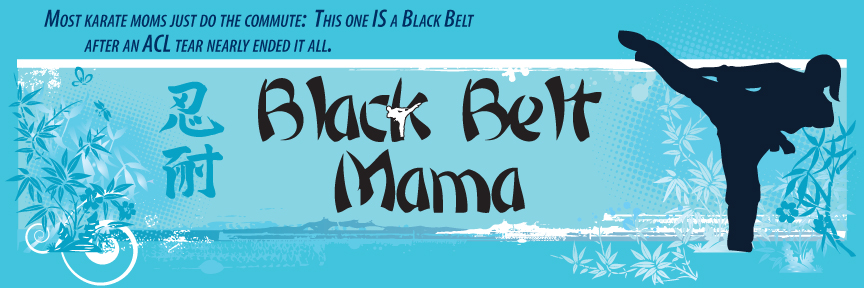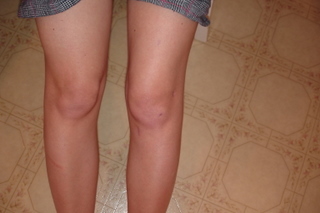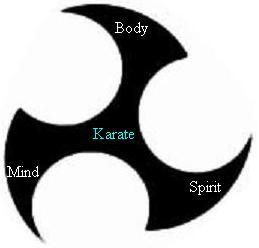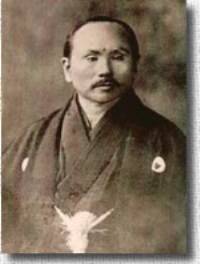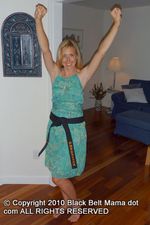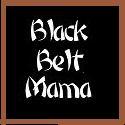Three Months and Counting
Yesterday marked three months since my ACL reconstruction. I am officially at the half way point now and it feels good to be able to start counting days on the other end of the spectrum until I can go back to karate. Most of my swelling is gone, although a small bit still remains. One of the scars is barely visible; the others will make my summer wardrobe take on a warrior look.
After being so sick last week, I lost seven pounds. I feel like those seven pounds came directly off my recovering leg. PT was challenging last week as I got back into the swing of things. This week, my PT is going to start me on some crazy weighted exercises where he puts a harness around my waist and I get to run away from the machine, pivot and then stand there while the weight tries to pull me back. It’s better than being harnessed to a person on a stool with wheels, which I hear is a common practice for ACL recoverees.
Currently my extension (how flat and straight I can get my leg) is pretty good. But I do have to work at it a bit to get it all the way down. My flexion (how far I can bend my leg) is getting there although these last degrees have been hard to come by. I’m currently fluctuating between 145-148 degrees of flexion, not normal for most people, but not good enough for a gumby-like character like me. My other foot will flop back and easily touch my butt and that’s the goal for my recovering leg as well. 155 is the number that I need to get to in order for that to happen. It still hurts like hell when I’m pushing it to get another degree. I can’t imagine that changing anytime soon, but will look forward to the day it does.
I’m still going down the stairs like Lil C. Bad leg, good leg, one step at a time. It makes for very slow progress, progress that is sometimes too slow for even Lil C. Right now, it’s still putting too much pressure on the front of my knee. I sometimes can’t imagine what it will be like to be able to just run up or down the stairs. I’ve seen many men come back faster in this area and I think it’s directly related to their amount of muscle versus mine (think stick legs).
With spring and summer right around the corner, I’ve become much more concerned about the disparity between my two legs. One goes to -20 extension; the other hits 0 and that’s it. One has a muscular thigh; the other is still lagging considerably behind. I imagine I’ll have a lot of explaining to do as the pants get shorter and swimsuit season arrives.
The biggest challenge of this entire process has been staying on top of my exercises. It’s so easy to just watch "Jon & Kate Plus Eight" or another repeat on HGTV instead of riding the bike. The PT gets very monotonous, time-consuming and frustrating. I think that as the weather warms, I’ll be more inspired to stay on the exercise train. It’s been far to easy to fall off after being sick and nursing the girls back to health as well as keeping our house spotless all the time for potential showings.
I am hoping that in another three months I can report that I’ve survived my first night back in the dojo. Summer is always such a great time for karate. Being able to get outside and work with the bo, and breaking a good sweat at class is always enjoyable. I’m looking forward to being able to do that soon. The countdown starts now.
Three months to go. . .
Why Your Child is Not a Black Belt
Filed under: Admired Martial Artists Month, Guest Post, Tales from the dojo
By: Ann-Marie K. Heilman, Kyoshi
Okinawa Kenpo Karate Kobudo
Heilman Karate Academy, Inc.
To the uninformed person on the street or perhaps the new student in the dojo, all black belts may seem alike. The parent of a child whose classmate at school is an 8-year-old third degree black belt may have the feeling, “What is holding up my child’s progress?” Are all schools alike? Is there one course of study that, when followed will end with the coveted “black belt?” Or is one school easier than another? Is one school really that different from another? The answer to a traditionalist is a resounding YES! We need to do some fact finding.
In the Okinawan/Japanese systems, wearing a black belt is a sign of maturity; in other words, the student has demonstrated mature physical growth, knowledge of the physical basics of their system, has demonstrated over time an ability to make sound judgments thus revealing mental maturity. None of this is accomplished very quickly even if the student is an adult.
When we discuss techniques in class we judge a student’s ability and knowledge and expertise of technique compared to an attacker. In adults, body size usually does not change drastically. With children’s growing bodies techniques must change as their bodies change; their arm and leg length for example, as well as their height, will render some techniques useless or perhaps better depending upon their current physical size. This generally is not true for adults who reach their maximum growth by the late teens and will stay there for years.
When we consider adult versus child judgment or mental maturity we find a difference. Why consider sound judgment as a marker of black belt eligibility? Think about self-control or quick judgment in a street situation. There are adults who should not study martial arts. They haven’t learned self-control. They lose their temper, use martial arts as a "power game" over others or do not use good judgment in everyday matters. Certainly martial arts can provide them with an opportunity to learn these virtues but that depends on the quality of instruction, which is factor of the school they attend. And all schools are not alike.
In terms of the definition of a "black belt" there are many different ideas. Some systems promote individuals who are good athletes and can kick high, punch hard, and/or win trophies. There is nothing wrong with this idea, but a traditional view of the rank implies mental maturity. This does not come early in a person’s life but develops slowly over time.
We know of many kids who are excellent in the physical aspects of their art and we might call them "junior black belts” to recognize their proficiency, but they are still children. Can they teach? Sometimes. I have known a few children who can convey information better than some adults. Can they make sound judgments about people? Sometimes. But not always. That takes experience and maturity. Should we "hold them back" until they are 16? Usually, but not always. At many traditional dojos those individuals who demonstrate ability can be recognized by awarding them a junior black belt. However, full ranking is generally held off until maturity has been demonstrated and that does not come easily or quickly.
Curriculum is another matter. As a traditional dojo, the HKA offers a full program of okinawan karate and Kobudo (weapons). From basics (stances, kicks, blocks, strikes), through self-defense, sparring, to participating in demonstrations, tournaments, and dojo events – we cover a lot of material.
Sport karate is a new development that came into existence in America in the "60’s. It has blossomed and grown into a billion dollar business. It is a lot of fun and those who have accumulated a number of trophies will tell you the great feeling of accomplishment they have when they win. But sport karate is different from traditional karate where "points" don’t matter; your performance and development as a person in mind, body, and spirit does. There is much more to say on this matter and we will continue the discussion in future blogs.
Diagnosis Happy
Doctors who are diagnosis happy should not communicate with parents who are google happy. It makes for a very unpleasant relationship and two very stressed out parents.
On Monday, our daughter’s doctor diagnosed her with ITP, despite the fact that her rash was clearing up, despite the fact that her platelet levels were on the rise. She insisted that Big I be treated like a pin cushion once again. Yesterday she had more blood drawn, and we’re not sure if there was more blood or tears leaving her body. It is a traumatic thing for a kid, one that I didn’t want her to have to endure more than once.
Today, Big I’s doctor called with the results. She’s a DO and she’s brand spanking new. Our regular doctor left the practice and we’ve been seeing anyone who will have us lately. We’re usually very happy with the doctors there but for now, we’re without our main one. She started the phone call by telling me that Big I’s platelets have returned to normal levels. In fact, they were really quite good. The normal low range is 150,000. Her reading was 300,000. Fabulous.
Then she went on to say that she tested for some other things and of course, something turned up. The air temporarily left the room and I had to sit down because I felt like the weight of the world was just crushing my chest. She started talking about elevated liver enzymes and an elevated ANA level which signifies "rheumatoid disorders." She told us she wanted us to see a pediatric rheumatologist specialist in a nearby city and that levels like these can be indicators of early-onset lupus.
I didn’t know what to say. I was in shock and devastated all over again. I called Mr. BBM at work and I called my Mom. My Mom is an RN and she works with two excellent doctors. While we were discussing things, I mentioned to my Mom, "Couldn’t her liver enzymes be elevated due to her being on antibiotics? Can’t antibiotics do that?" My Mom quickly pulled out her PDR and what we found in the side effects section of Big I’s antibiotic was nothing short of a list of her problems: ITP resulting from the antibiotic, elevated liver enzymes from a reaction to the drug. And why wouldn’t she be allergic to this drug? The entire family, me, Mr. BBM and Lil C, are all allergic to penicillin, severely allergic to penicillin.
I called Mr. BBM and discussed Ackam’s Razor: the simplest solution usually applies; and we decided together that this doctor is diagnosis happy. She diagnosed ITP on Monday; then admitted she doesn’t have it today. She’s insisting we cart Big I all over the state to meet with specialists when the truth is, the kid doesn’t have a single symptom of the disease. Not one. Isn’t it at least possible that her messed up levels are due to an allergic systemic reaction from the antibiotic?
When Lil C reacted to a drug in that family, she swelled up like the Pillsbury Dough-boy and had our doctors asking if we had any history of lupus or Juvenile Rheumatoid Arthritis in the family. We have no family history of anything like that in our family. A dose or two of steroids and Lil C was back to normal. Isn’t it possible that Big I’s reaction stuck to her insides? Wouldn’t elevated liver enzymes indicate a reaction to the drugs?
The doctor admitted it’s only a small chance that something is wrong with Big I, but still went ahead and scheduled an appointment for her that, truth be told, we will probably cancel. Submitting your child for testing when they need it is one thing; submitting your child to a lifestyle of doctors appointments and diagnoses that immediately jump to the worst possible conclusion is not a road we’re interested in traveling. We took her off the antibiotic and think she should have a retest in a couple weeks when she’s entirely better and the drug is out of her system completely.
So, my question is, why did it take two stressed out and concerned parents and an RN Grandma to see the most obvious potential problem here? We are definitely asking to see a different doctor next time, and I am definitely laying off the google. Talk about needing a break from a "drug."
Where Will We Take the Martial Arts?
An Exploration Into the Classical Ways of Training
BY: MATTHEW APSOKARDU
The world is arriving at a critical point in martial arts transmission. Fewer and fewer original masters remain from direct Asian lineages of the various fighting arts. Leading the way now is the first generation of global students. These soldiers and students from the U.S., along with areas like Europe and Australia, are becoming the key to proper transmission of classical martial arts.
While these few men and women struggle to transmit their knowledge fully, they must battle against the behemoth that is modernization and capitalism. Karate and tae kwon do schools pop up in every strip mall, offering quick belts and flashy techniques with no obligation required except monetary compensation.
Nor can we underestimate the impact of Mixed Martial Arts. MMA offers an eclectic amalgam of techniques while forgoing activities like kata. MMA has produced many great fighters and is a legitimate form of combat exercise – but also steers many potential students away from traditional training.
Truly, it is up to the next generation, the kyu ranks and lower dan ranks of every style, to learn how to learn the old way; to refuse the easy gratification of trophies, money, and false notoriety and pursue the intangible goals of the past.
The big question is – how do we go about training classically?
The following are a few quick tips with that goal in mind. This is a very sparse list; simply some key points that I believe are important and that I continue to work on personally. This is not an analysis of techniques, nor is it a guide to sparring. But for those seeking something of the old budo heart, it may be helpful.
In trying to keep things "old style", I would like to break down my suggestions in traditional karatedo fashion – Body, Mind, and Spirit.
TO TRAIN YOUR BODY:
Stick Around
If you want to get anything out of a classical style, you have to stick around. Six months won’t cut it. Six years won’t cut it. The way old-style teaching operates is through repetition and muscle memory. After developing a rock solid foundation, instructors will then teach you how to work outside of kata and routine drills. But if you ditch once you get a first degree black belt, all you’ve got is a couple of prearranged exercises. Not very useful against a live opponent.
Many of the most advanced techniques found in old arts are just extraordinarily refined basics. Strikes made with perfect timing at precision targets, delivered in a strategic order, result in some stunning effects (if you’ll excuse the pun). It takes a while to learn these targets, and even longer to utilize them correctly against free-willed opponents who don’t feel much like getting hit.
The best way to ensure ‘sticking around’ is to first realize what you want in a core style. Look into different styles and realize which fits your lifestyle and body type. Once you’ve established that, keep it your core style and develop around it (to learn more about this training theory, consult Forrest Morgan’s "Living the Martial Way.") Remember, sports are sports. Some schools simply don’t teach classical theories, so if you want them, keep looking.
Investigate
Do your homework! Don’t cringe, just do it. Actually…cringe. The martial art universe is epically large and hard to put together. When you first begin studying, it will seem all but impossible to put your own style’s history together, let alone how it interacts with all the other styles, and how those styles interact with other countries, and so on and so forth. Even now when I think about the vast martial scape it makes my head spin. But the old masters made it their business to know such things, and so must we. Not to mention, by reading from credible sources and watching videos of legitimate masters, any martial artist’s eyes can be opened to an array of concepts and ideas they never considered before; and the best part is, it doesn’t matter what rank you are. There WILL be something to learn.
Remember, the old Okinawan sensei intermingled their ideas and techniques. They bounced concepts off of each other in the hopes of refining their systems. They learned from multiple instructors and utilized those techniques that worked best (yes, it’s true. You eclectic folk can remind your hard-lining friends).
TO TRAIN YOUR MIND:
Don’t Obsess Over Rank
Ranking in martial arts started off innocently enough – Jigoro Kano wanted to gauge the progress of his students. Unfortunately, rank has become a bit of a monster and brings out negative qualities in a lot of people. Many lust after rank. Many abuse it once it’s attained. Others will cheat and barter just to get it. This is not at all what was originally intended.
The old budo styles were used to prepare samurai, and to a lesser extent soldiers, for battle. Sword cuts, empty hand techniques, spear thrusts…as much as they could pack into the minds of the combatants before war began. There was no time and no need for rank because one simple factor evaluated your skill level – whether or not you lived.
It’s ok to feel grateful and honored as rank comes to you, but putting more stock in it than that can lead to some of the troubling situations we see abundant today.
Optimize your mental acuity
Mental prowess is very valuable. Being able to effectively process that which you see and how you react is one of the benefits of martial art training. But there is a lot more to it. Mushin is a term that roughly translates to "no mind" and refers to a complete readiness and quieting of the mind. When a karateka effectively utilizes mushin, processing what you see and reacting is no longer necessary - there is simply reaction. Beyond mushin is zanshin, roughly translated as "remaining mind." Zanshin helps keep a martial artist aware of his surroundings at all times and alert for that which may come. One who utilizes zanshin is aware of the position of the sun, the condition of terrain, and every movement of his opponent. Forrest Morgan equates it to a wolf that hovers over his opponent, teeth bared and ready to break his opponent’s neck at the first sign of movement.
One who trains in mushin and zanshin may begin to develop the Budo ideal of Shugyo No Mokuteki. Or as Miyomoto Musashi explained it, "a mind as high as Mt. Fuji…you can see all things clearly. And you can see all the forces which shape events; not just the things happening near you." By developing your mind in this manner, conflict can be resolved or avoided before it begins.
In order to reach mushin a heavy emphasis on kata should be maintained. Kata can be a mobile form of meditation and teaches the body, through extensive repetition, to move without conscious thought.
To reach zanshin, a martial artist must carry their art with them at all times. They must constantly analyze scenarios, environments, body language, and ‘gut feelings’ experienced in the hara (lower abdomen region). This, combined with dojo training and kumite, is critical.
Explore without Deviation
One of the biggest complaints about older arts is their seemingly stodgy nature. Moves in kata seem quaint and unrealistic. They appear completely unresponsiveness to the ever-changing nature of attackers.
That’s true…if you never explore. Kata, or prearranged attack-defense sequences, are useful as learning devices. The concepts in each kata are carefully devised, multipurpose actions that, once ingrained in the mind, can become infinitely useful. Once technique and good habits are reflexive instead of thought-induced, the practitioner can more fully explore the art (and thus scenario, intent, opponent, and other variables are opened up for consideration).
Unfortunately, problems arise with hardcore explorers. Sometimes, they fall in love with their own interpretation and decide to change kata and material entirely. These people believe they are changing things for the better. For that specific person, maybe it is better. But kata and traditional arts are designed to train everyone, and can flex for specific needs, but must be flexed back to their original form if they are to be sustained for future students.
Think of kata as a book. You first read the words in the book, but then your imagination takes hold and creates a whole world around those words. You wouldn’t go changing the words to better fit your imagination would you? No, because then the next reader won’t be able to explore the original masterpiece.
TO TRAIN YOUR SPIRIT:
Realize the Purpose
Karate and other traditional arts are not simply about fighting. They are about Life Protection (if I may borrow a term from a writer later in this month – Kyoshi Bill Hayes). The classical martial artist protects those around him/her and even protects the lives of wayward attackers by withholding technique as much as possible; but if the situation demands it, responds with devastating consequences. Furthermore, practitioners of do arts (karatedo, judo, taekwondo, kyudo, kendo, iaido, hapkido, aikido, etc.) concern themselves with following "the way."
On the surface, "the way" of any martial art is simply the unique approach that art takes toward combat. "The way" of aikido involves melding with an opponent’s energy and using their own force against them. "The way" of tae kwon do is the utilization of both hand and foot techniques, but with a strong emphasis on kicking. These stylistic differences are notable, but not really the reason the old masters placed do on the end of their arts. Instead, they intended "the way" to be a path in which students could build their character and reach self actualization.
To better understand such character building, here are just a few precepts written by Funakoshi Gichin, founder of Shotokan Karate and considered the father of Japanese karate:
– Karate-Do strives internally to train the mind to develop a clear conscience, enabling one to face the world honestly, while externally developing strength to the point where one may overcome even ferocious wild animals. Mind and technique become one in true karate.
– Just as it is the clear mirror that reflects without distortion, or the quiet valley that echoes a sound, so must one who would study Karate-Do purge himself of selfish and evil thoughts, for only with a clear mind and conscience can he understand that which he receives.
– He who would study Karate-Do must always strive to be inwardly humble and outwardly gentle. However, once he has decided to stand up for the cause of justice, then he must have the courage expressed in the saying, "Even if it must be ten million foes, I go!" Thus, he is like the green bamboo stalk: hollow (kara) inside, straight, and with knots, that is, unselfish, gentle, and moderate.
– To win one hundred victories in one hundred battles is not the highest skill. To subdue the enemy with out fighting is the highest skill.
– When you look at life think in terms of karate. But remember that karate is not only karate — it is life.
In order to better understand Funakoshi Sensei, we must scrutinize all of our actions, even when no one is looking. We have to let the perfection we strive for in technique infect the way we think, so that flaws in character are slowly chipped away through the power of will. Anything less falls short of our founder’s ideals. Furthermore, we need to remind ourselves that martial arts are a lifelong endeavor, and no matter what, there is always a way to improve.
In our modern time, transmission of these classical ideals can be very difficult. Parents bring children to various dojo in order to learn self-defense, not to be preached at. Furthermore, they are concerned that Asian philosophies that resemble Shinto and Buddhism will interfere with their chosen faith. Generally, the concept of ‘respect’ is well received; but once ‘honor’, ‘humility’, ‘veracity’, etc. make an appearance, the acceptance isn’t as ready. It’s a very tricky mire to navigate, and that is why every student must take it upon themselves to study and investigate such concepts on their own. If they’re lucky, they will meet an instructor who is willing to help them along the way.
Consider Body/Mind/Spirit
Separately, each is useful; but it’s the harmonic coordination of the three that makes a classical martial artist. If one branch exists without the other, the journey is incomplete. Only by training in all three can we achieve that indescribable characteristic so noticeable in the old masters – Heijo Shin: A peaceful mind.
In Conclusion – "Part the Clouds, See the Way"
This may all sound like a bit much. No lie, it’s a handful. But the senior teachers out there right now went through the same ordeals, and even more. It’s up to us, the lower ranks, to receive as much of their knowledge as we can and to avoid slipping off the right path. I don’t write this as one who has accomplished everything, but as one who struggles alongside you. Hopefully, together, we can all keep the true nature of the martial arts alive!
MA
That “Break” Can Come ANYTIME Now
Big I had her follow-up finger stick today. The nurse asked Mr. BBM to put pressure on her finger for 30 seconds after. When he released, her finger began dripping again. She also had two petichial spots in her mouth that weren’t there on Friday. Despite the platelet reading being better today, the doctor is convinced that she does indeed have ITP. I spent the weekend thinking this was a temporary set-back and today I just can’t deal with any of this.
She has to have more blood work done on Wednesday and they are sending all of her results to a specialist at a hospital an hour away. She can’t go outside for recess, participate in gym class, or take karate for the time-being. She’s signed up to play t-ball with her best friend and the doctor said we’ll have to wait and see whether or not she’ll be able to play.
She’s back at school today and I just want to be there, shielding her from anyone who might run into her or hurt her in any way. I can’t imagine being told I couldn’t go out to recess or play in gym class as a kid. She’s going to be devastated. I am just reeling today with the weight of it all and just don’t know what to do with myself.
